For the 5-step conscious copy method, jump to here.
For the language-shift cheat sheet, go here.
–
You’re scrolling through your inbox. Two subject lines catch your eye.
- First one screams: “URGENT! 24 HOURS LEFT – Don’t Miss This Life-Changing Opportunity!”
- Second one says: “We have something that might help with your marketing challenges.”
Which one makes you feel respected as a human being?
The difference between these two approaches captures the heart of conscious copywriting. According to HubSpot’s State of Marketing report, 82% of consumers stay loyal to brands they trust. And trust isn’t built through manipulation.
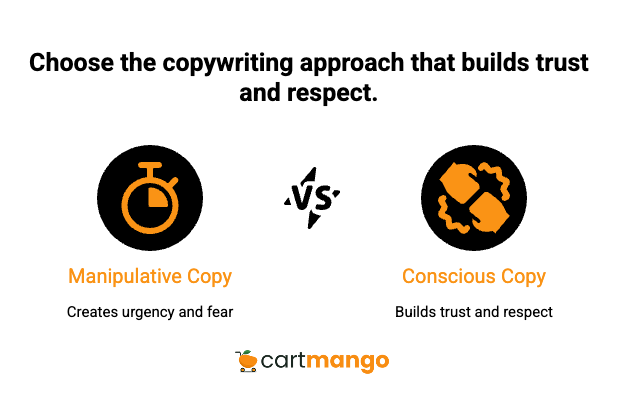
Here’s what I’ve learned after years of watching copywriters chase quick wins only to burn out their audiences. There’s a better way.
What “Conscious Copywriting” Means
Conscious copywriting is persuasion with a conscience.
It’s writing that sells while respecting your reader’s intelligence and autonomy.
The term first appeared around 2012 in small marketing circles. By 2020, it gained mainstream attention as consumers grew tired of being manipulated. Now in 2025, it’s becoming the standard for brands that want to build lasting relationships.
Here’s the shift I’m seeing:
Manipulative Approach | Conscious Approach |
|---|---|
“Buy now or lose forever” | “Available while supplies last” |
“Everyone’s doing it” | “This worked for similar businesses” |
“Secret formula revealed” | “Here’s our straightforward method” |
The old way treats readers like wallets with legs. The new way treats them like thinking, feeling humans who deserve respect.
Market Forces Driving the Shift
Three forces are pushing this change faster than ever before.
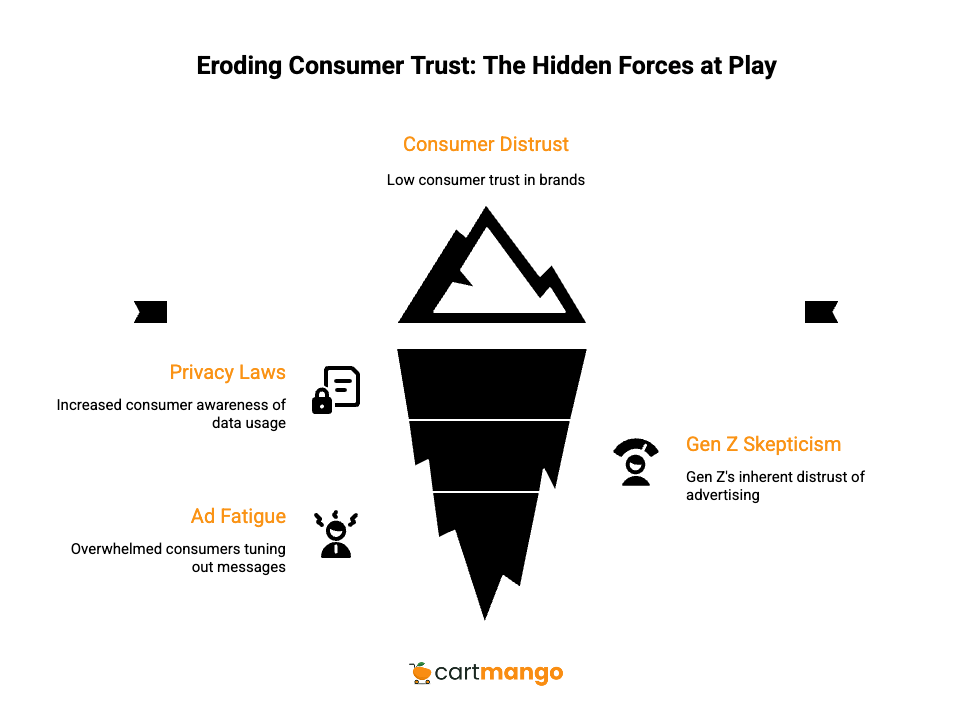
1/ Privacy laws like GDPR and CCPA have made consumers more aware of how their data gets used. They’re asking harder questions about the messages they receive.
2/ Generation Z consumers, now entering their prime spending years, have grown up with ad blockers and sponsored content warnings. They can spot manipulation from a mile away.
3/ Ad fatigue. People are overwhelmed by the sheer volume of messages hitting them daily.
Only 34% of consumers trust most of the brands they buy or use (Source: Edelman). That’s a crisis for any business trying to build relationships.
What does this mean for your business?
Simple: The brands that win will be the ones that choose transparency over trickery. They’ll build trust instead of exploiting psychological triggers.
The Science of Ethical Persuasion
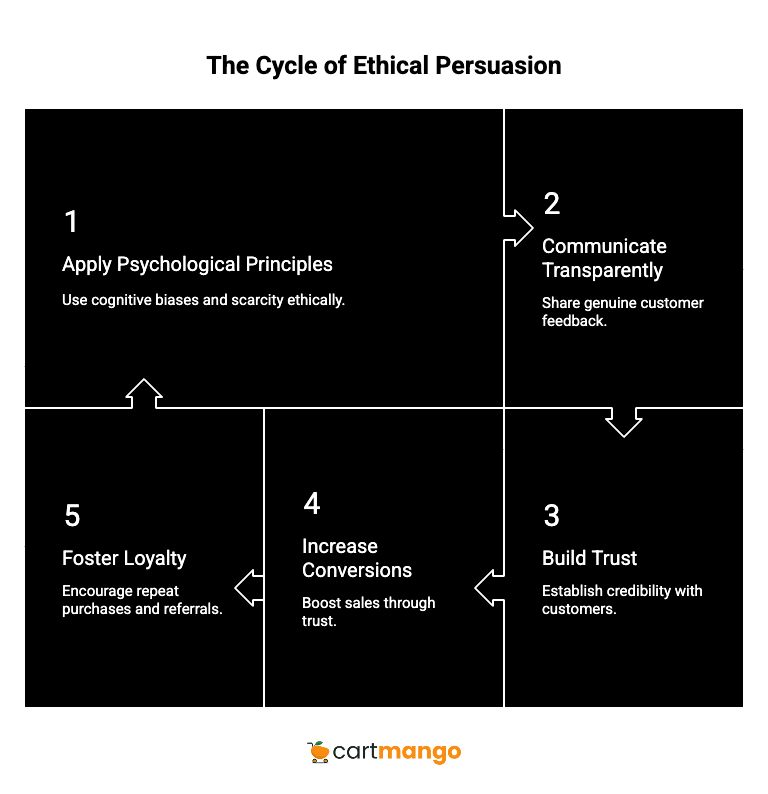
But here’s where it gets interesting. You can still use psychology in your copy without being manipulative.
People abandon websites with vague or overly promotional claims. They want clarity, not clever wordplay.
Cognitive biases still work. Social proof still matters. Scarcity still creates urgency.
The difference is in how you apply these principles.
Take social proof.
Instead of saying “Thousands of people love this,” you could say “Here’s what three recent customers told us about their experience.” The first approach feels like marketing speak. The second feels like honest communication.
Transparency increases conversion rates over time (source). When people trust you, they buy more often and refer their friends.
The science is clear: Ethical persuasion isn’t just morally right. It’s more profitable in the long run.
4 Pillars of Conscious Copy
Every piece of conscious copy stands on 4 pillars. Miss one, and your message falls apart.
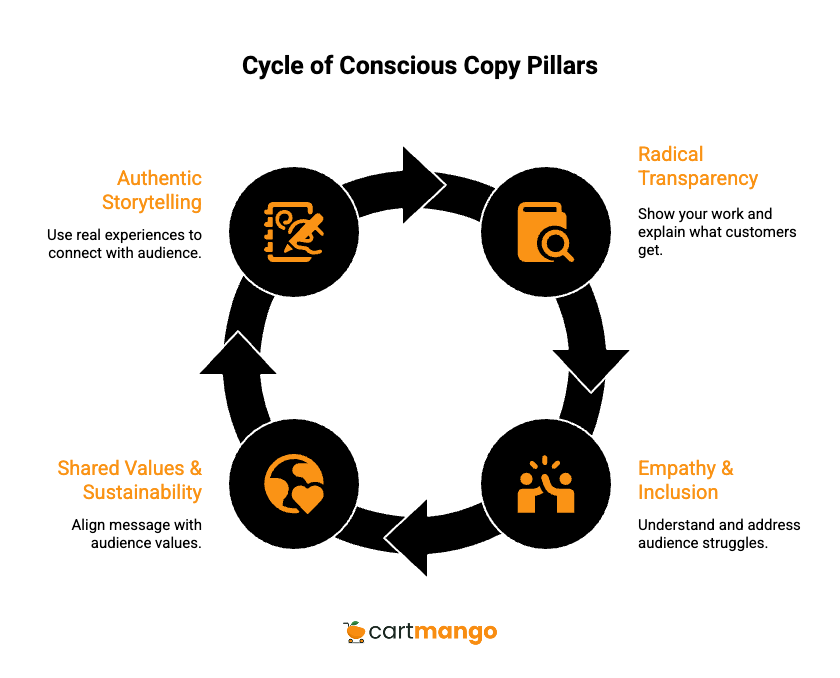
1/ Radical Transparency
This means showing your work. Instead of hiding behind vague promises, you explain exactly what customers get. Simple disclosure example: “This course took me 6 months to create and includes 12 hours of video content.”
2/ Empathy & Inclusion
This requires understanding your audience’s real struggles. Empathetic language can increase trust and engagement.
3/ Shared Values & Sustainability
It means aligning your message with what your audience cares about. This isn’t about jumping on every social cause. It’s about being authentic to your brand’s core values.
4/ Authentic Storytelling
This uses real experiences instead of manufactured drama. Patagonia’s “Don’t Buy This Jacket” campaign worked because it reflected their genuine commitment to environmental responsibility.
Here’s a practical tool I use to shift my language:
Language-Shift Cheat-Sheet
Manipulative Phrase | Conscious Reframe | Intended Psychological Effect |
|---|---|---|
“Limited-Time Only!” | “Available for a limited period so we can maintain quality.” | Gentle urgency focused on quality |
“Don’t Miss Out!” | “We invite you to explore this offer if it feels right for you.” | Curiosity without FOMO pressure |
“Act Now or Regret Later.” | “Take action whenever you’re ready – no rush.” | Supports autonomy; lowers fear |
“Buy Before It’s Gone.” | “We have a small batch ready—order when it suits you.” | Sets clear expectations |
“Only a Few Left!” | “Inventory is low; reserve yours if it’s a good fit.” | Transparent scarcity, calm tone |
The 5-Step Conscious Copy Method
This method works for emails, sales pages, social media posts, and even casual conversations with potential customers.
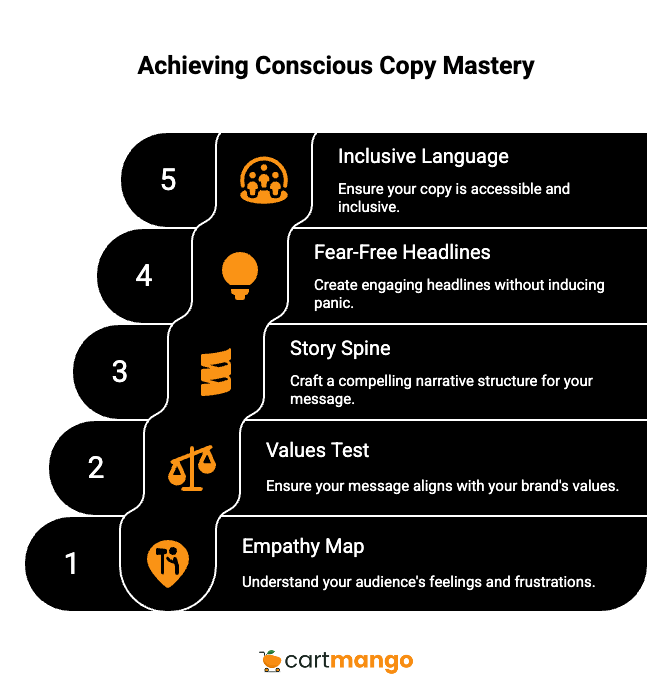
Step 1: Create Your Empathy Map
Start by understanding who you’re writing for. Not their demographics, but their actual feelings and frustrations.
I use this simple template:
“My reader is feeling [emotion] about [situation] because [reason]. They want [outcome] but worry about [concern].”
Example:
“My reader is feeling overwhelmed about their marketing because they’re getting conflicting advice from different sources. They want a clear strategy but worry about wasting money on the wrong approach.”
You can create a visual empathy map using Miro’s templates. Spend 15 minutes on this step. It will save you hours of revisions later.
Step 2: The Values-Litmus Test
Before writing a single word, ask yourself these 3 questions:
- Does this message align with my brand’s core values?
- Would I be comfortable if my competitor used this exact language?
- Does this help my reader make a better decision, even if they DON’T buy?
If you answer “no” to any of these, stop and rethink your approach.
Step 3: Story-Spine Formula
Every persuasive message needs a story backbone.
Use this structure:
- Setup: Here’s the situation you’re in.
- Conflict: Here’s what’s making it challenging.
- Resolution: Here’s what’s possible.
- Invite: Here’s how we can help you get there.
Before: “Our revolutionary system will transform your business overnight!”
After: “Running a business can feel overwhelming when you’re handling everything yourself. The daily tasks pile up, and you wonder if you’ll ever get ahead. Many business owners find relief by systemizing their processes. We’d love to show you how our approach might help.”
Step 4: Fear-Free Headline Matrix
Headlines don’t need to create panic to create interest.
Use this 3×3 grid:
Problem + Possibility + Proof
- Problem words: Challenge, Struggle, Question
- Possibility words: Method, Approach, Guide
- Proof words: Tested, Real, Practical
Example combinations:
- “The Marketing Challenge That Has a Tested Solution”
- “A Practical Approach to Your Business Struggles”
- “Real Solutions for Your Growth Problems”
Step 5: Inclusive-Language & WCAG Mini-Checklist
Accessibility isn’t optional in 2025. Use this checklist for every piece of copy:
- Alt-text for images describes the content, not just “image”
- Reading level stays at 8th grade or below
- Gender-neutral language when possible
- Color contrast meets WCAG standards
- Plain English over industry jargon
The W3C’s Web Content Accessibility Guidelines provide detailed standards for digital accessibility.
Bonus: Conscious CTA Builder
End every message with this formula:
Benefit + Permission + Next Step
E.g. “This approach might help you save 5 hours a week on content creation. If that sounds useful, you can download our free template below.”
Measuring Success Beyond Conversions
Most copywriters measure everything by click-through rates and conversion percentages. But conscious copywriting requires a different scorecard.
Triple-Lens Impact Scorecard
Lens | KPI Example(s) | How to Track | Check-In | Target Benchmark* |
|---|---|---|---|---|
Tangible | CTR, CVR, AOV | Google Analytics / e-com dashboard | Weekly | ≥ industry avg & trending up |
Relational | NPS, Repeat Sessions, Referral % | 2-min surveys; CRM reports | Monthly | Upward trend QoQ |
Transformational | Customer Stories, Impact Quotes, Mission Alignment | Interviews, testimonial videos, social listening | Quarterly | Positive sentiment & alignment |
*Benchmarks vary; focus on continuous improvement.
Legend: CTR = Click-Through Rate, CVR = Conversion Rate, AOV = Average Order Value, NPS = Net Promoter Score
The transformational lens matters most. This tracks whether your copy actually helps people improve their lives or businesses.
Consider collecting impact stories by sending a simple email every quarter: “What’s changed in your business since we started working together?”
The responses can surprise you.
Red-Flags
Watch out for these warning signs in your copy:

Woke-washing: Using social justice language without backing it up with real actions. Customers see right through this.
Hidden fees: Burying important information in fine print. This destroys trust faster than any discount can build it.
Clever over clear: When your headline requires a second read to understand, you’ve lost most of your audience.
Missing alt-text: Ignoring accessibility hurts real people and your search rankings.
Finding Your Voice as a Conscious Copywriter
The world is drowning in marketing campaigns that feel hollow. Conscious business owners are changing this, one message at a time.
When you write copy using ethical marketing practices, your writing skills will feel rusty.
Here’s what nobody tells you: becoming a confident conscious copywriter takes time. Your ideal client won’t appear overnight. But when you focus on clear communication instead of tricks, something shifts.
The golden rule applies here. Communicate with clients the way you want brands to talk to you.
Your marketing strategy should match your intention. When it does, you’ll stop chasing reader’s attention and start earning it. This is crucial for the future of ethical marketing.
Working with Conscious Copywriters: What to Expect
Maybe you’re thinking about hiring help for your marketing efforts.
Most conscious copywriters work on an hourly basis or monthly retainer. The right fit depends on your vision and budget.
A good person will dig into your pain points before they write copy. They’ll ask about your ideal client until they can picture that person clearly.
They’ll help you find the right words for your content writing projects. But here’s what surprised me: the best marketers will challenge you when your marketing strategy doesn’t align with your values.
This collaboration gets everyone involved in creating something better. Your voice becomes stronger. Your message reaches the right people.
When conscious business owners work with skilled copywriters, they deliver what the world needs: honest communication.
Trust & Impact: Your Dual Profit Levers
Conscious copywriting isn’t about being nice. It’s about being smart.
When you respect your readers, they reward you with attention, trust, and ultimately, sales. When you help them make better decisions, they tell their friends about you.
The businesses thriving will be the ones that choose long-term relationships over short-term gains.
What’s your next step?
Pick one piece of copy from your current marketing and run it through the 5-step Conscious Copy method. See how it feels different when you write from a place of service instead of desperation.
Your customers will notice the difference. So will your bottom line.
Related
- Sellfy vs Payhip: The Recurring Revenue Prison (2026)
- Podia vs Gumroad: The Recurring Revenue Handcuffs (2026)
- SendOwl vs Gumroad: The Recurring Revenue Black Hole (2026)
- Gumroad vs Sellfy: The Vendor Lock-in Cage (2025)
- Gumroad vs Payhip: The Hidden Trap for Creators (2025)
- ThriveCart vs SamCart – The Subscription Hostage Trap (2025)
- 8 ThriveCart Alternatives & The Lifetime Pricing Paradox (2025)
- 8 SamCart alternatives + Subscription hostage (2025)
- The GENTLE Method: Soft marketing for creators
- How Far in Advance Should You Promote a Webinar?
